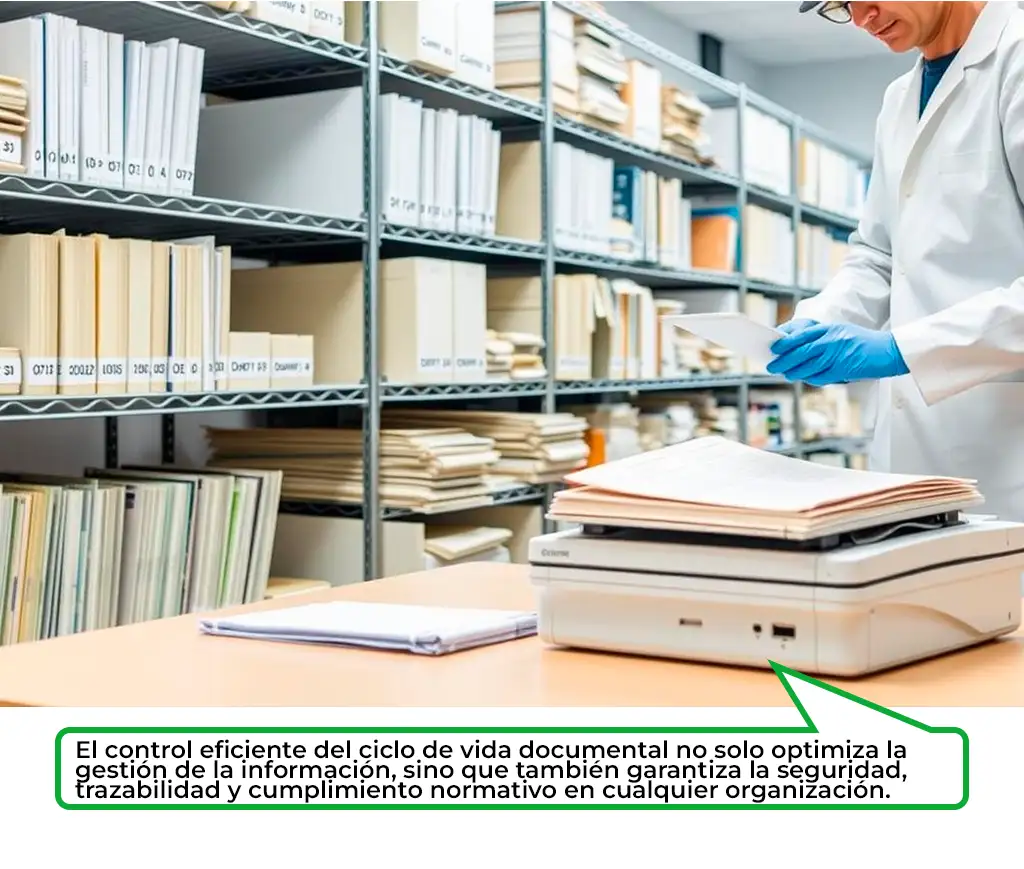The document life cycle is defined as the set of stages a document goes through from the moment it is created, through its use and storage, until its eventual permanent archiving or disposal. Documents are born at the time of their creation, remain in use as long as they have functional or administrative value, and are later evaluated to determine whether they should be preserved for a longer period or destroyed.
What does the document life cycle mean?
The document life cycle is the structured sequence of phases a document goes through throughout its existence. This concept covers everything from the creation of the document to its destruction or permanent preservation. Throughout this process, documents are stored for specific periods, which in many cases are regulated by legal standards or internal policies. These regulations aim to ensure organizational transparency, prevent institutional fraud, and improve administrative efficiency
The Importance of Properly Applying the Document Life Cycle
Proper implementation of the document life cycle is vital for effective information management within a company. It is estimated that up to 20% of files can be lost due to storage errors. This poor practice not only leads to the loss of valuable information, but also to duplicated efforts, delays in processes, and general disorganization. To avoid these issues, it is essential to clearly define the status of each document: what tasks are pending, who needs to review or send it, and what actions have been taken so far.
Often, the document life cycle is implemented through task template systems, known as workflows, which help organize actions related to documents. Although the workflow concept is closely associated with document management, they should not be confused. Workflows automate processes such as review, task assignment, progress tracking, and alert generation, while the document life cycle focuses on the longevity and handling of the document over time. Modern document management platforms allow the design and customization of multiple life cycles and workflows, enabling full control over an organization's content.
Reasons to Prioritize the Document Life Cycle
Proper management of the document life cycle helps ensure the appropriate handling of stored data, protects confidential information, and supports regular file cleanups that optimize the use of both physical and digital storage space. In addition, this practice enhances operational efficiency and reduces costs associated with the unnecessary storage of outdated documents.
-
Efficient Document Organization
Applying the document life cycle facilitates the classification and organization of documents from their origin. This approach allows files to be located more quickly and ensures that related tasks are carried out smoothly.
-
Protection of Sensitive Data
Another benefit of the document life cycle is its role in protecting critical or confidential information. Companies can establish access protocols, encryption, and permissions to ensure that only authorized personnel handle sensitive documents.
-
Institutional Archive Cleanup
The document life cycle also makes it possible to define the precise moments when useless documents should be eliminated, reducing repository overload. This helps keep archive systems in optimal and up-to-date conditions.

Stages of the Document Life Cycle
The document life cycle begins with the generation of the document. This stage marks the starting point of its journey and includes the initial input of information, whether physical or digital, within the organization.
1. Creation
The document life cycle begins with the generation of the document. This stage marks the starting point of its journey and includes the initial input of information, whether physical or digital, within the organization.
2. Organization and Classification
After creation, the document must be labeled and organized. This is done through the assignment of metadata that indicates its content, context, and purpose. This additional information facilitates the search and retrieval of documents in later phases of the document life cycle.
3. Collaboration and Review
During this stage, multiple users interact with the document either simultaneously or sequentially. Access levels and permissions are defined, and the necessary information is shared to ensure that all stakeholders can access the relevant content.
4. Verification
Before the document moves to the next phases, it must be verified to ensure it meets the company’s quality standards. This review process allows errors or inconsistencies to be detected and ensures the most updated version is being used.
5. Retention or Disposal
The final stage of the document life cycle determines which documents should be retained and which should be eliminated. This decision must be based on document retention policies and current legal regulations. In the case of disposal, it is essential to ensure that sensitive information is securely destroyed.
Purpose of the Document Life Cycle
The main objective of the document life cycle is to effectively manage each stage that documents go through—whether to dispose of them at the appropriate time or to preserve them permanently due to their legal, administrative, or historical relevance. This practice not only improves operational efficiency but also fosters an organizational culture based on document control and information traceability.
What Does Proper Monitoring of the Document Life Cycle Involve?
Effective control of the document life cycle involves unifying and standardizing procedures to prevent common errors, such as task duplication. If multiple employees work in parallel without coordination, unnecessary efforts are likely to be repeated. Therefore, strictly following the document life cycle allows for time optimization, redundancy avoidance, and ensures consistent management.

Types of Documents Affected by the Document Life Cycle
In a business context, the document life cycle impacts various types of records, including administrative, commercial, and electronic documents.
Administrative Documents
These documents contain essential information about the internal operations of the organization. The application of the document life cycle to these records depends on their ongoing updates and the legal regulations governing their retention. They should be preserved as long as they are useful or as long as legally required.
Commercial Documents
Commercial records document business transactions and operations. Their retention within the document life cycle is regulated by tax and commercial laws, which define the minimum retention period.
Electronic Documents
In this case, the document life cycle covers everything from the digital creation of the document and its processing through document management systems to its inclusion in an electronic archive. This electronic management enables greater traceability and control of the content.
How to Protect and Manage the Document Life Cycle?
There are various tools and technological approaches to ensure proper management of the document life cycle. Among the most notable are:
- Electronic Document Management Systems (EDMS): These programs allow for comprehensive management of the document life cycle, including version control, permissions, workflows, and audits.
- Enterprise Content Management Systems (ECM): Solutions that handle not only documents but also other types of content such as images and emails. They incorporate compliance mechanisms and records management features.
- Business Process Management Systems (BPM): These platforms automate tasks associated with the document life cycle by defining workflow rules, alerts, assignments, and approvals that facilitate control and tracking.
Act Now!
Contact Us Now!
Implement an efficient document life cycle management system and transform the way your company organizes, protects, and disposes of information.








